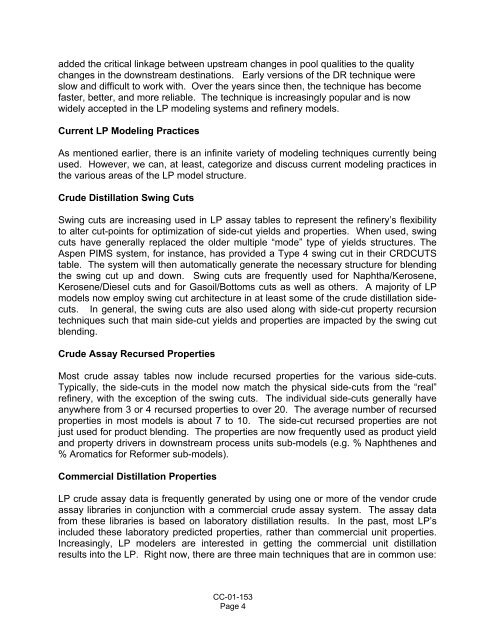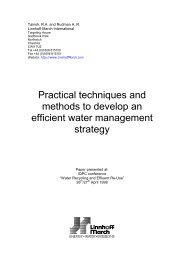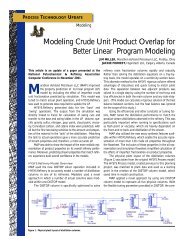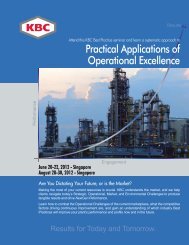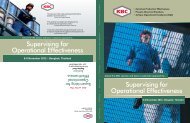LP Modeling - Past, Present and Future
LP Modeling - Past, Present and Future
LP Modeling - Past, Present and Future
You also want an ePaper? Increase the reach of your titles
YUMPU automatically turns print PDFs into web optimized ePapers that Google loves.
added the critical linkage between upstream changes in pool qualities to the quality<br />
changes in the downstream destinations. Early versions of the DR technique were<br />
slow <strong>and</strong> difficult to work with. Over the years since then, the technique has become<br />
faster, better, <strong>and</strong> more reliable. The technique is increasingly popular <strong>and</strong> is now<br />
widely accepted in the <strong>LP</strong> modeling systems <strong>and</strong> refinery models.<br />
Current <strong>LP</strong> <strong>Modeling</strong> Practices<br />
As mentioned earlier, there is an infinite variety of modeling techniques currently being<br />
used. However, we can, at least, categorize <strong>and</strong> discuss current modeling practices in<br />
the various areas of the <strong>LP</strong> model structure.<br />
Crude Distillation Swing Cuts<br />
Swing cuts are increasing used in <strong>LP</strong> assay tables to represent the refinery’s flexibility<br />
to alter cut-points for optimization of side-cut yields <strong>and</strong> properties. When used, swing<br />
cuts have generally replaced the older multiple “mode” type of yields structures. The<br />
Aspen PIMS system, for instance, has provided a Type 4 swing cut in their CRDCUTS<br />
table. The system will then automatically generate the necessary structure for blending<br />
the swing cut up <strong>and</strong> down. Swing cuts are frequently used for Naphtha/Kerosene,<br />
Kerosene/Diesel cuts <strong>and</strong> for Gasoil/Bottoms cuts as well as others. A majority of <strong>LP</strong><br />
models now employ swing cut architecture in at least some of the crude distillation side-<br />
cuts. In general, the swing cuts are also used along with side-cut property recursion<br />
techniques such that main side-cut yields <strong>and</strong> properties are impacted by the swing cut<br />
blending.<br />
Crude Assay Recursed Properties<br />
Most crude assay tables now include recursed properties for the various side-cuts.<br />
Typically, the side-cuts in the model now match the physical side-cuts from the “real”<br />
refinery, with the exception of the swing cuts. The individual side-cuts generally have<br />
anywhere from 3 or 4 recursed properties to over 20. The average number of recursed<br />
properties in most models is about 7 to 10. The side-cut recursed properties are not<br />
just used for product blending. The properties are now frequently used as product yield<br />
<strong>and</strong> property drivers in downstream process units sub-models (e.g. % Naphthenes <strong>and</strong><br />
% Aromatics for Reformer sub-models).<br />
Commercial Distillation Properties<br />
<strong>LP</strong> crude assay data is frequently generated by using one or more of the vendor crude<br />
assay libraries in conjunction with a commercial crude assay system. The assay data<br />
from these libraries is based on laboratory distillation results. In the past, most <strong>LP</strong>’s<br />
included these laboratory predicted properties, rather than commercial unit properties.<br />
Increasingly, <strong>LP</strong> modelers are interested in getting the commercial unit distillation<br />
results into the <strong>LP</strong>. Right now, there are three main techniques that are in common use:<br />
CC-01-153<br />
Page 4


